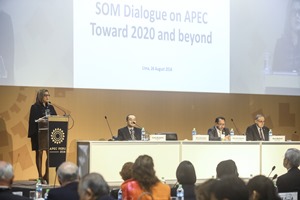 Co-organized by 2016 APEC SOM (Senior Official Meeting) Chair's Office (Peru) and PECC
Co-organized by 2016 APEC SOM (Senior Official Meeting) Chair's Office (Peru) and PECC
[Photo credit: Courtesy of APEC Secretariat]
Program agenda
In 1994, APEC’s Economic Leaders committed to achieve the goal of free and open trade and investment in the Asia-Pacific by no later than 2020. Less than five years before this deadline, APEC finds itself within an increasingly crowded international architecture and operating in a more complex and dynamic region. Combined, these factors not only compel us to boost our efforts to achieve the Bogor Goals, but also to start developing a post-2020 vision that identifies and anchors itself in APEC’s unique value-add. 2020, an iconic year for APEC, therefore presents an opportunity to redefine and reinforce APEC’s role. And to get this right by 2020, we need to start the conversation now.
Peruvian Vice President Mercedes Araoz delivered a keynote speech at the Dialogue and acknowledged having been part of PECC's Trade Policy Forum to work on Competition Policy project in her previous life as an academic while at the Universidad del Pacifico of Peru.
Bogor Goals
In addition to achieving free and open trade and investment in the Asia-Pacific no later than the year 2020, the Bogor Goals included a subset of elements such as commitment to the multilateral trade system, trade facilitation, consultations on economic growth strategies, regional capital flows and other macro-economic issues, as well as to intensify development cooperation to attain sustainable growth and equitable development for APEC economies.
APEC is currently finalizing its second-term Bogor Goals review. The initial findings suggest that, since the Bogor Goals were launched, average applied tariffs have fallen and it is getting faster and cheaper to trade across borders. Extreme poverty has dropped by 83.5%, life expectancy continues to increase, and enrolment in tertiary education has more than doubled.
However, the initial findings also suggest that some sectors (i.e. agriculture) have seen higher tariffs, and greater use of non-tariff measures affecting trade. Behind-the-border restrictions continue to affect services trade and investment, negative perceptions on restrictions facing foreign investors are more prevalent and, on average, unemployment and inequality is higher than it was before the Global Financial Crisis. This ‘unfinished business’ should be addressed as much as possible in the coming years, and should also inform our development of APEC’s post-2020 vision.
Four priority areas discussed at the SOM Dialogue are: services, investment, agriculture, and economic & technical cooperation.
Regional and International Context
APEC’s post-2020 vision should also take into account the profound global and regional changes that have occurred since APEC’s launch 27 years ago. For example, there has been a twelve-fold increase in the number of free trade agreements in the region, as well as the TPP and forthcoming RCEP, not to mention the eventual FTAAP. In developing APEC’s post-2020 vision, we should remain supportive of these processes, while recognizing that they ultimately lie ‘outside’ APEC. APEC retains its unique role in fostering a more integrated and prosperous Asia-Pacific, and we should continue to focus on redefining and reinforcing this role moving forward.
The field of regional and international fora has also become more crowded, partly reflecting the emergence of more complex issues requiring collective responses, including in the Asia-Pacific. Fora as diverse as the G20, EAS, ASEAN, OECD have all expanded their work in the region in recent years, leading on issues ranging from climate change and quality development, to international financial stability and regional security.
At the same time, the United Nations has reshaped its approach towards international cooperation through the newly adopted Sustainable Development Goals, a tangible set of aspirational and crosscutting objectives and targets. Moreover, the Human Development approach has proved its usefulness as a comprehensive criterion to measure progress towards development.

 Co-organized by 2016 APEC SOM (Senior Official Meeting) Chair's Office (Peru) and PECC
Co-organized by 2016 APEC SOM (Senior Official Meeting) Chair's Office (Peru) and PECC